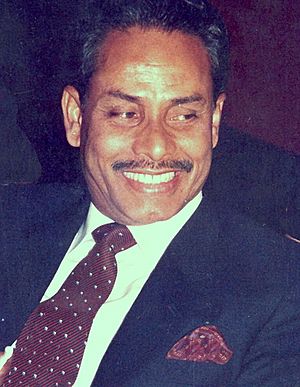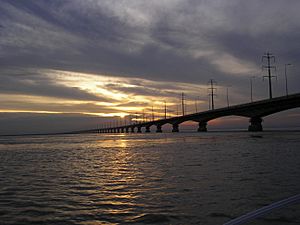Hussain Muhammad Ershad facts for kids
Quick facts for kids
Hussain Muhammad Ershad
|
|
|---|---|
|
হুসেইন মুহাম্মদ এরশাদ
|
|

Ershad in Bangabhaban, 1986
|
|
| Leader of the Opposition | |
| In office 3 January 2019 – 14 July 2019 |
|
| Prime Minister | Sheikh Hasina |
| Preceded by | Rowshan Ershad |
| Succeeded by | Rowshan Ershad |
| President of Bangladesh | |
| In office 11 December 1983 – 6 December 1990 |
|
| Prime Minister | Ataur Rahman Khan Mizanur Rahman Chowdhury Moudud Ahmed Kazi Zafar Ahmed |
| Vice President | A. K. M. Nurul Islam Moudud Ahmed Shahabuddin Ahmed |
| Preceded by | A. F. M. Ahsanuddin Chowdhury |
| Succeeded by | Shahabuddin Ahmed |
| 4th Chief of the Army Staff | |
| In office 1 December 1978 – 30 August 1986 |
|
| President | Ziaur Rahman Abdus Sattar A. F. M. Ahsanuddin Chowdhury |
| Preceded by | Lieutenant General Ziaur Rahman |
| Succeeded by | Lieutenant General Atiqur Rahman |
| Personal details | |
| Born | 1 February 1930 Dinhata, Cooch Behar State, British India (now in West Bengal, India) |
| Died | 14 July 2019 (aged 89) Dhaka, Bangladesh |
| Political party | Jatiya Party (E) |
| Spouses |
Rowshan Ershad
(m. 1956)Bidisha Siddique Ershad
(m. 2000; div. 2005) |
| Children |
|
| Relatives |
|
| Alma mater | University of Dhaka Officers Training School, Kohat, Pakistan Command and Staff College, Quetta, Pakistan |
| Profession | Military officer, politician |
| Awards | UN Population Award UN Environment Award Global Officials of Dignity Award |
| Military service | |
| Allegiance | |
| Branch/service | |
| Years of service | 1952–1971 (Pakistan) 1973–1986 (Bangladesh) |
| Rank | |
| Commands | 4th Chief of the Army Staff, Adjutant General of the Army, CO, 7th East Bengal Regiment, CO, 3rd East Bengal Regiment |
Hussain Muhammad Ershad (Bengali: হুসেইন মুহাম্মদ এরশাদ; 1 February 1930 – 14 July 2019) was an important political leader in Bangladesh. He was a high-ranking army officer who later became the President of Bangladesh. He served as president from 1983 to 1990.
He took control of the government in 1982 while he was the head of the army. He became president in 1983. He then won an election in 1986. Many people saw his time as president as a period when the military had a lot of power. He had to step down in 1990 after many people protested for a more democratic government.
Ershad started his own political group called the Jatiya Party in 1986. After leaving the presidency, he became a member of parliament in 1991. He was re-elected many times after that.
During his time as president, Ershad worked on several projects. He helped improve roads and highways. He also supported the creation of the South Asian Association for Regional Cooperation (SAARC). This group helps countries in South Asia work together. He also made Islam the official state religion in 1989.
In 1987, the United Nations gave Ershad an award. This was for his work on population and environmental issues.
Contents
Early Life and Military Career
Ershad was born in 1930 in a place called Dinhata. This area was part of British India at the time. His parents were Mokbul Hossain and Mazida Khatun. His father was a lawyer and worked for the local ruler. Ershad was the oldest of nine children.
His family moved to what is now Bangladesh in 1948. This happened after India was divided into two countries. Ershad went to Carmichael College and later graduated from the University of Dhaka in 1950.
In 1952, Ershad joined the Pakistan Army. He trained as an officer in Kohat. He also took advanced courses at the Pakistan Command and Staff College in 1966. Before Bangladesh became independent, he led different army groups.
Bangladesh's Independence and Army Role
During the Bangladesh Liberation War, Ershad was held as a prisoner of war in West Pakistan. In 1973, he returned to the newly independent nation of Bangladesh.
After returning, he joined the Bangladesh Army. He was appointed as the Adjutant General by the first president, Sheikh Mujibur Rahman. The army in Bangladesh faced some challenges after independence. This was because some officers had fought in the war, while others had been held captive.
In 1975, President Sheikh Mujibur Rahman was killed. After some changes in leadership, Ziaur Rahman became the Army Chief. He appointed Ershad as the Deputy Chief of Army Staff. Later, Ziaur Rahman became president and made Ershad the new Chief of Army Staff. Ershad became a close advisor to President Ziaur Rahman.
Becoming President
After President Ziaur Rahman was killed in 1981, Ershad supported the new government. However, in 1982, Ershad took control of the government. He became the Chief Martial Law Administrator. This meant the army was in charge.
In 1983, Ershad became the President of Bangladesh. He made some changes to the country's laws. He supported a law in 1984 that gave important rights to farmers who rented land. He also worked to sell off some government-owned businesses.
Ershad played a key role in starting the South Asian Association for Regional Cooperation (SAARC) in 1985. This group helps countries in South Asia work together on political and economic issues. He also helped bring together the leaders of India and Pakistan.
As president, Ershad changed the country's constitution. He declared Islam as the state religion. He also created a new system for local government in rural areas. He held elections for these local councils in 1985.
Elections During His Time
Ershad formed his own political party, the Jatiya Party, in 1986. He ran for president in 1986 and won. However, some major opposition parties did not take part in this election.
Later, in 1987, Ershad dissolved the parliament. This happened because of growing protests from opposition groups. He held new elections in 1988. Again, many main opposition parties refused to participate.
Ershad's time as president is sometimes seen as a long period of military rule. The elections held during his time were often criticized by opposition parties.
What He Achieved
Ershad helped make the Bangladesh Armed Forces more stable. Before his time, the army had faced many changes in leadership. He helped unite different parts of the army.
The Bangladesh Armed Forces did not try to take over the government again until 1996. Ershad also allowed the Bangladesh Army to join United Nations Peacekeeping Operations for the first time in 1988. This helped the army gain experience and also brought money to the country.
He also oversaw many projects to build roads and other important structures, especially in rural areas.
Challenges and Protests
During Ershad's time, there were reports of problems like violence and corruption. These issues have been a challenge for the country.
In 2011, the Supreme Court of Bangladesh declared that Ershad's military rule from 1982 was illegal. However, many of the actions taken during his rule remained valid.
Important Projects
Ershad started the plan for the Jamuna Bridge. This is a very important bridge in Bangladesh. He created an organization in 1985 to build it. He also helped raise money for the project.
He received two awards from the United Nations during his presidency:
- UN Population Award (1987)
- UN Environment Award (1987)
Pressure for Democracy
Many political parties joined together against Ershad's government. These included the BNP, led by Khaleda Zia, and the Awami League, led by Sheikh Hasina. They organized protests and strikes that affected the whole country.
Students also joined the protests. These strong protests eventually forced Ershad to step down on 6 December 1990. The countries in the West, who had supported him, also stopped their support.
Ershad appointed Justice Shahabuddin Ahmed to lead a temporary government. This government was set up to prepare for new democratic elections. Justice Shahabuddin Ahmed then ordered Ershad's arrest.
After his arrest, Ershad still ran in the 1996 election from jail. He won in all the areas he ran in. Later, he was released from jail in 1997.
Political Career After 1991
Ershad was one of the few high-profile politicians to be found guilty of certain charges and serve time in prison. However, many cases against him were later dismissed.
He sometimes changed his political alliances. He worked with both the Awami League and the BNP at different times, depending on the political situation.
In 2008, Ershad's Jatiya Party joined forces with the Awami League for the December election. They formed a "Grand Alliance." Ershad ran in three different areas and won in all of them.
In 2014, Ershad's party had a controversial election. After this election, Ershad became a special envoy for Prime Minister Sheikh Hasina. His wife, Rowshan Ershad, became the leader of the opposition party. Some members of his party were also part of the government.
Personal Life
Ershad married Rowshan Ershad in 1956. They had a son named Saad Ershad and a daughter named Jebin Ershad. Rowshan Ershad was also a successful politician. She was elected to parliament five times. After Ershad's death, she became a senior leader of the Jatiya Party.
Ershad later married Bidisha Siddique in 2000. They had a son named Eric Ershad. Their marriage ended in divorce in 2005.
Death
Ershad became ill and was admitted to Combined Military Hospital in Dhaka in June 2019. He passed away on 14 July 2019, at the age of 89. His state funeral was held two days later.
See also
 In Spanish: Hossain Mohammad Ershad para niños
In Spanish: Hossain Mohammad Ershad para niños





